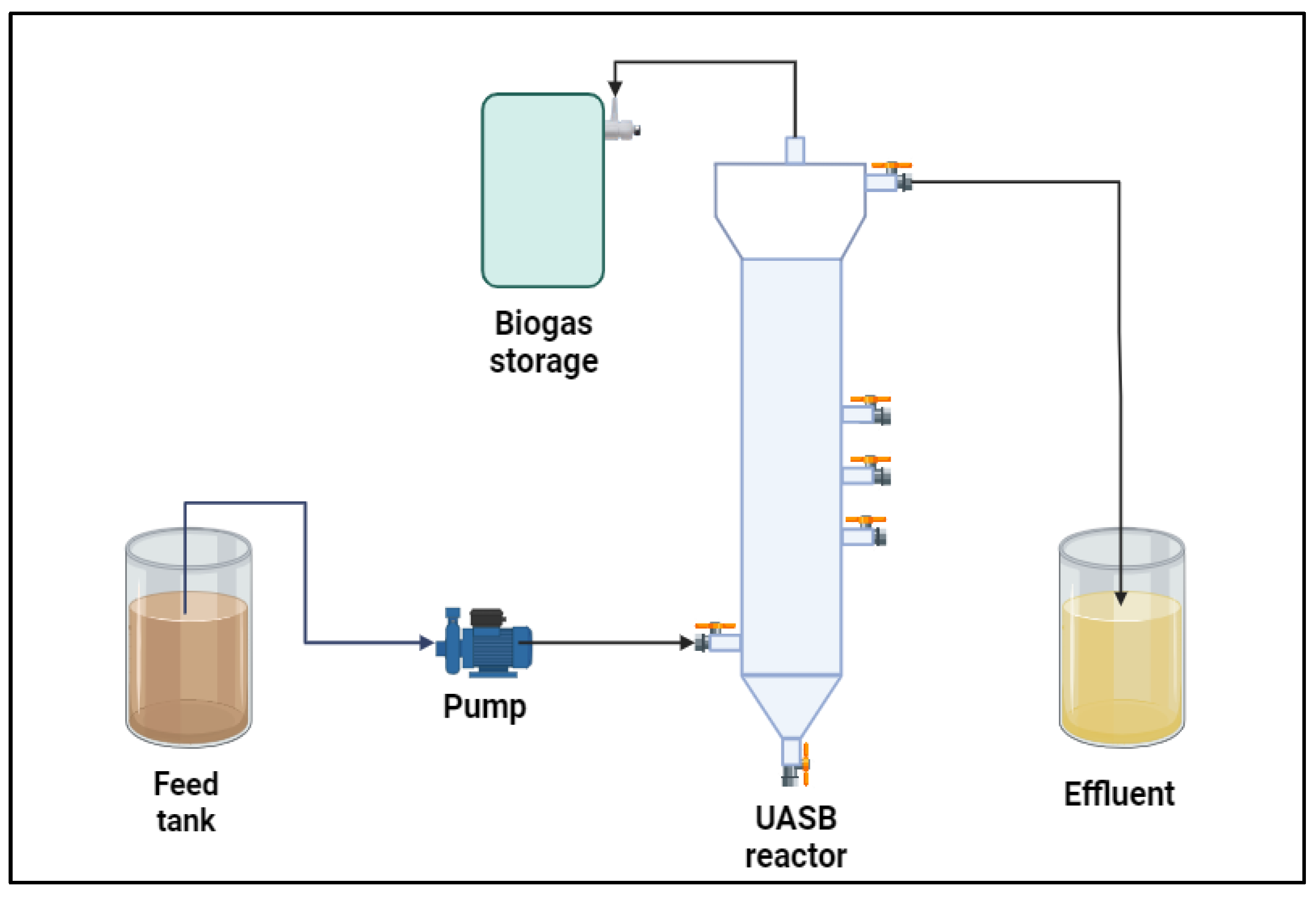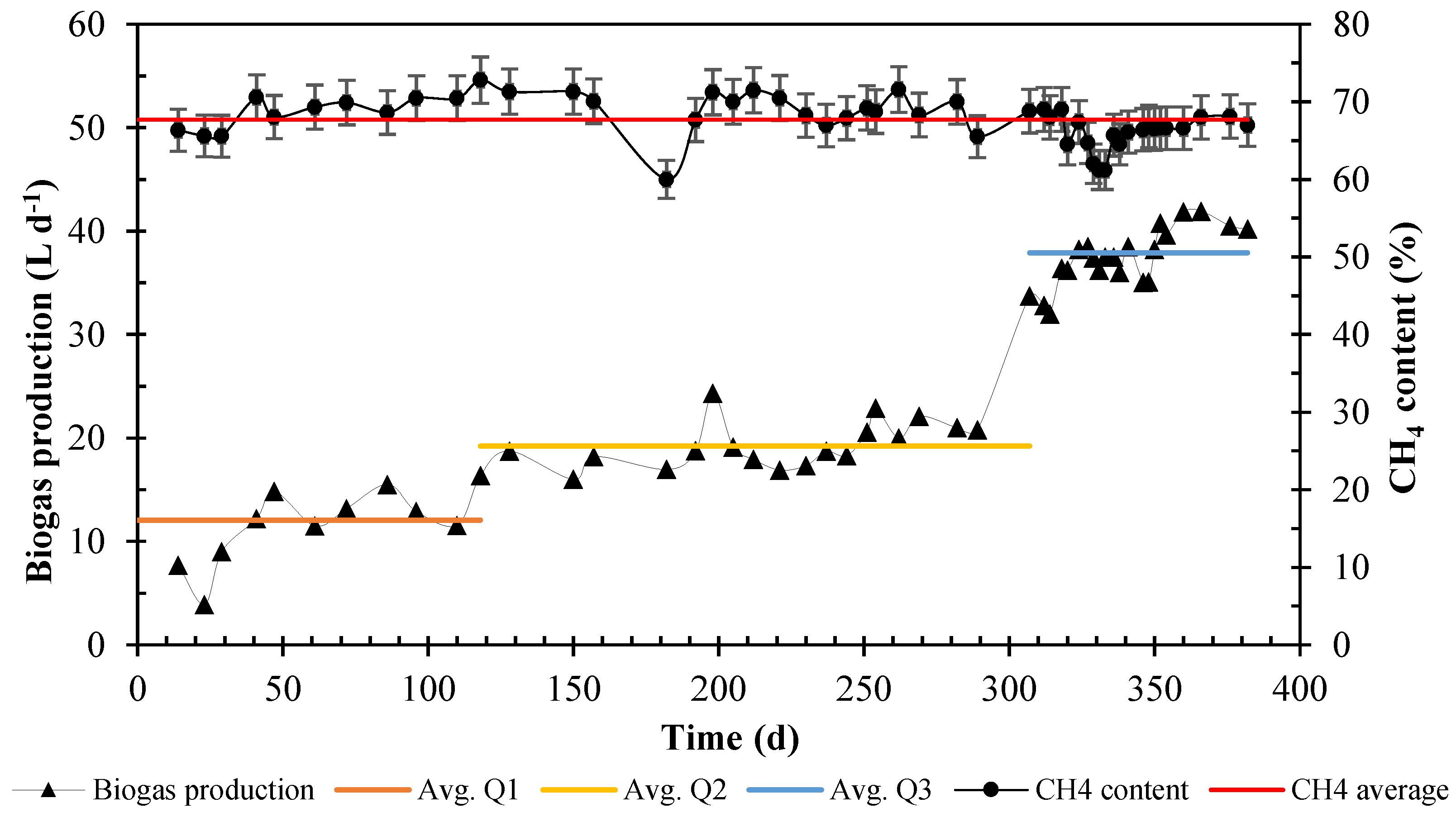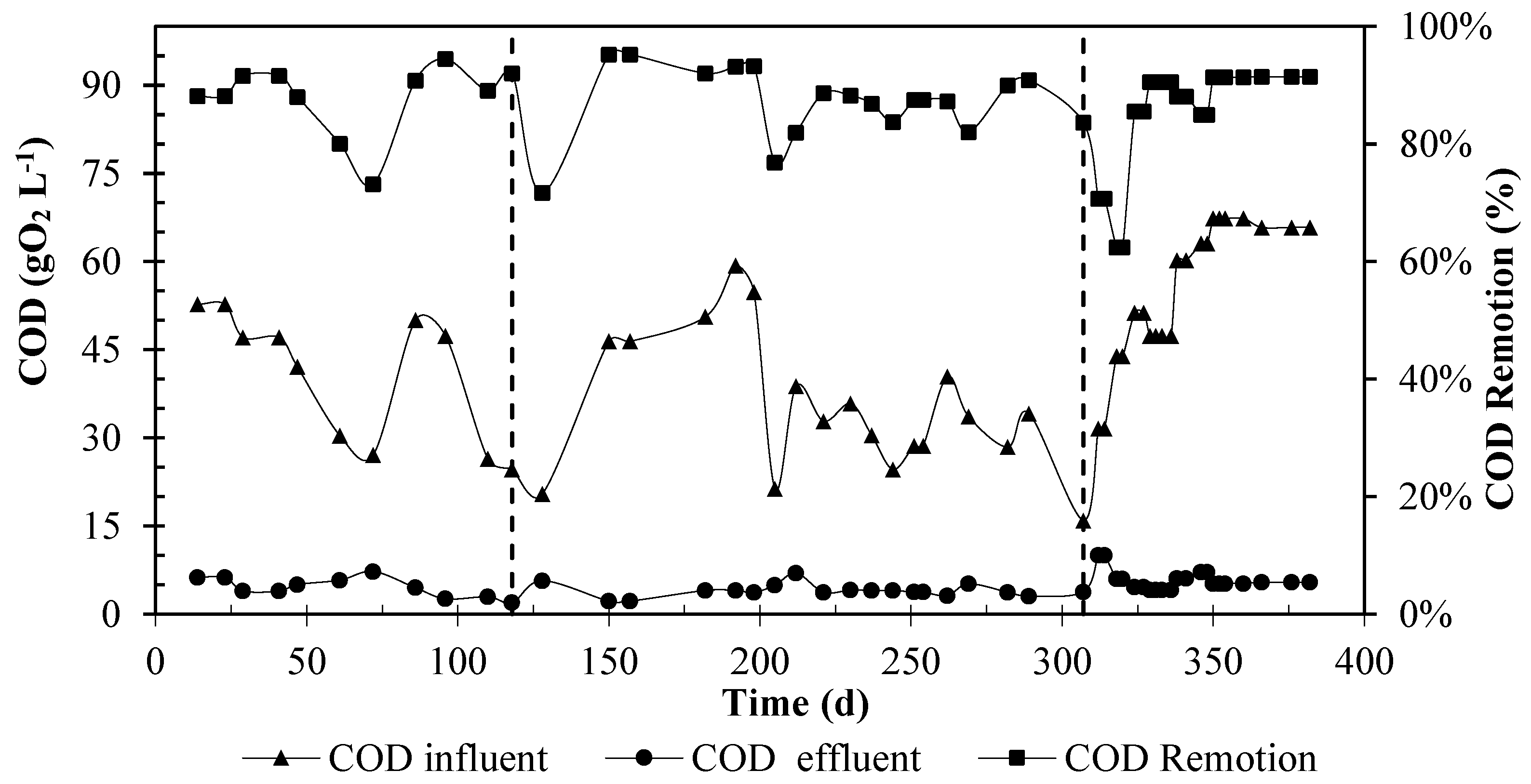Evaluation of Biogas Production from Swine Manure Using a UASB Reactor (Upflow Anaerobic Sludge Blanket) with Long-Term Operation
Abstract
1. Introduction
2. Materials and Methods
2.1. Collecting and Handling Substrate
2.2. Upflow Anaerobic Sludge Blanket (UASB) Reactor for Biogas Production
2.3. Performance Evaluation of UASB Reactor for Biogas Production Using Swine Manure
2.4. Swine Manure Characterization
2.4.1. Determination of Total Solids
2.4.2. Determination of Volatile Solids
2.4.3. Determination of Volatile Fatty Acids (VFAs) and Alkalinity (ALK)
2.4.4. Quantification of Chemical Oxygen Demand (COD)
2.4.5. Calculation of Organic Load Remotion Using COD as a Parameter
2.5. Determination of Performance of Reactor UASB fed with Swine Manure
2.5.1. Measurement of Biogas Production
2.5.2. Biogas Composition Analysis
3. Results
3.1. Swine Manure Characterization
3.2. Reactor UASB Performance for Biogas Production
3.3. COD, VS, Organic Load Rate (OLR), and Hydraulic Retention Time (HRT) Results
3.4. Alkalinity (ALK), Volatile Fatty Acids (VFAs), and ALK/VFA Ratio
4. Conclusions
Author Contributions
Funding
Data Availability Statement
Acknowledgments
Conflicts of Interest
References
- IEA. Renewables 2023; IEA: Paris, France, 2024. [Google Scholar]
- Statista Cumulative Renewable Energy Capacity Worldwide from 2010 to 2022. Available online: https://www.statista.com/statistics/1094331/global-renewable-capacity-cumulative/ (accessed on 31 March 2024).
- Figueroa Castro, A.C.; Mojica, J.L. Informe Perspectiva Sectorial de Energía. Actualidad del Sector Energético Colombiano; Corficolombiana: Bogotá, Colombia, 2023. [Google Scholar]
- UPME. Plan Energético Nacional Colombia: Ideario Energético 2050; UPME: Bogotá, Colombia, 2015. [Google Scholar]
- Deublein, D.; Steinhauser, A. Biogas from Waste and Renewable Resources; Wiley: Hoboken, NJ, USA, 2008; ISBN 978-3-527-31841-4. [Google Scholar]
- Pinto, J.A.; Barros, R.M.; dos Santos, I.F.S.; Filho, G.L.T.; de Oliveira Botan, M.C.; Bôas, T.F.V.; de Cássia Crispim, A.M. Study of the Anaerobic Co-Digestion of Bovine and Swine Manure: Technical and Economic Feasibility Analysis. Clean. Waste Syst. 2023, 5, 100097. [Google Scholar] [CrossRef]
- IEA. IEA Bioenergy Task 37—A Perspective on the State of the Biogas Industry from Selected Member Countries; IEA: Paris, France, 2022. [Google Scholar]
- CIbiogás. Panorama Do Biogás No Brasil; CIbiogás: Foz do Iguaçu, Brasil, 2021. [Google Scholar]
- Duarte, S.; Loaiza, B.; Majano, A.M. De la Práctica a la Política: Análisis de las Barreras a la Inversión en Biogás en Colombia y las Medidas Para Abordarlas, a Partir de la Experiencia de los Desarrolladores y Otros Actores Relevantes; LEDS LAC: Bogotá, Colombia, 2021. [Google Scholar]
- Porkcolombia. Economía Porcícola 2020; Porkcolombia: Bogotá, Colombia, 2020; Volume 257. [Google Scholar]
- Pessuto, J.; Scopel, B.S.; Perondi, D.; Godinho, M.; Dettmer, A. Enhancement of Biogas and Methane Production by Anaerobic Digestion of Swine Manure with Addition of Microorganisms Isolated from Sewage Sludge. Process Saf. Environ. Prot. 2016, 104, 233–239. [Google Scholar] [CrossRef]
- Bao, M.; Cui, H.; Lv, Y.; Wang, L.; Ou, Y.; Hussain, N. Greenhouse Gas Emission during Swine Manure Aerobic Composting: Insight from the Dissolved Organic Matter Associated Microbial Community Succession. Bioresour. Technol. 2023, 373, 128729. [Google Scholar] [CrossRef]
- Tang, Y.; Wen, G.; Li, P.; Dai, C.; Han, J. Effects of Biogas Slurry Application on Crop Production and Soil Properties in a Rice–Wheat Rotation on Coastal Reclaimed Farmland. Water Air Soil Pollut. 2019, 230, 7–10. [Google Scholar] [CrossRef]
- He, Z.L.; Yang, X.E.; Stoffella, P.J. Trace Elements in Agroecosystems and Impacts on the Environment. J. Trace Elem. Med. Biol. 2005, 19, 125–140. [Google Scholar] [CrossRef]
- Lora, E.S.; Andrade, R.V. Biomass as Energy Source in Brazil. Renew. Sustain. Energy Rev. 2009, 13, 777–788. [Google Scholar] [CrossRef]
- Porkcolombia. Revista de Porkcolombia; Universidad Jorge Tadeo Lozano: Bogotá, Colombia, 2021. [Google Scholar]
- Rico, C.; Montes, J.A.; Rico, J.L. Evaluation of Different Types of Anaerobic Seed Sludge for the High Rate Anaerobic Digestion of Pig Slurry in UASB Reactors. Bioresour. Technol. 2017, 238, 147–156. [Google Scholar] [CrossRef]
- Lee, D.J.; Bae, J.S.; Seo, D.C. Potential of Biogas Production from Swine Manure in South Korea. Appl. Biol. Chem. 2018, 61, 557–565. [Google Scholar] [CrossRef]
- Amaral, A.C.; Kunz, A.; Steinmetz, R.L.; Scussiato, L.A.; Tápparo, D.C. Anaerobic Digestion of Swine Manure: Stratified Production Units and Its Biogas Potential. In Proceedings of the IV International Symposium on Agricultural and Agroindustrial Waste Management, Rio de Janeiro, Brazil, 5–7 May 2015. [Google Scholar] [CrossRef]
- Pomar, C.; Remus, A. Precision Pig Feeding: A Breakthrough toward Sustainability. Anim. Front. 2019, 9, 52–59. [Google Scholar] [CrossRef]
- Sefeedpari, P.; Pishgar-Komleh, S.H.; Aarnink, A.J.A. Model Adaptation and Validation for Estimating Methane and Ammonia Emissions from Fattening Pig Houses: Effect of Manure Management System. Animals 2024, 14, 964. [Google Scholar] [CrossRef]
- Evren, M.; Ozgun, H.; Kaan, R.; Ozturk, I. Anaerobic Treatment of Industrial Effluents: An Overview of Applications. In Waste Water—Treatment and Reutilization; InTech: Rijeka, Croatia, 2011. [Google Scholar]
- American Public Health Association; American Water Works Association; Water Environment Federation. Standard Methods for the Examination of Water and Wastewater; Bridgewater, L., Ed.; American Public Health Association: Washington, DC, USA, 2017; Volume 23. [Google Scholar]
- Rauw, W.M.; de Mercado de la Peña, E.; Gomez-Raya, L.; García Cortés, L.A.; Ciruelos, J.J.; Gómez Izquierdo, E. Impact of Environmental Temperature on Production Traits in Pigs. Sci. Rep. 2020, 10, 2106. [Google Scholar] [CrossRef] [PubMed]
- Renaudeau, D.; Gourdine, J.L.; St-Pierre, N.R. Meta-Analysis of the Effects of High Ambient Temperature on Growth Performance of Growing-Finishing Pigs. J. Anim. Sci. 2011, 89, 2220–2230. [Google Scholar] [CrossRef] [PubMed]
- Collin, A.; van Milgen, J.; Dubois, S.; Noblet, J. Effect of High Temperature on Feeding Behaviour and Heat Production in Group-Housed Young Pigs. Br. J. Nutr. 2001, 86, 63–70. [Google Scholar] [CrossRef]
- Wu, J.; Hu, Y.Y.; Wang, S.F.; Cao, Z.P.; Li, H.Z.; Fu, X.M.; Wang, K.J.; Zuo, J.E. Effects of Thermal Treatment on High Solid Anaerobic Digestion of Swine Manure: Enhancement Assessment and Kinetic Analysis. Waste Manag. 2017, 62, 69–75. [Google Scholar] [CrossRef] [PubMed]
- Lansing, S.; Martin, J.F.; Botero, R.B.; da Silva, T.N.; da Silva, E.D. Methane Production in Low-Cost, Unheated, Plug-Flow Digesters Treating Swine Manure and Used Cooking Grease. Bioresour. Technol. 2010, 101, 4362–4370. [Google Scholar] [CrossRef] [PubMed]
- Wang, H.; Larson, R.A.; Runge, T. Impacts to Hydrogen Sulfide Concentrations in Biogas When Poplar Wood Chips, Steam Treated Wood Chips, and Biochar Are Added to Manure-Based Anaerobic Digestion Systems. Bioresour. Technol. Rep. 2019, 7, 100232. [Google Scholar] [CrossRef]
- Francisco López, A.; Lago Rodríguez, T.; Faraji Abdolmaleki, S.; Galera Martínez, M.; Bello Bugallo, P.M. From Biogas to Biomethane: An In-Depth Review of Upgrading Technologies That Enhance Sustainability and Reduce Greenhouse Gas Emissions. Appl. Sci. 2024, 14, 2342. [Google Scholar] [CrossRef]
- Ro, K.S.; Woodbury, B.; Spiehs, M.; Szogi, A.A.; Silva, P.J.; Hwang, O.; Cho, S. Pilot-Scale H2S and Swine Odor Removal System Using Commercially Available Biochar. Agronomy 2021, 11, 1611. [Google Scholar] [CrossRef]
- Kumdhitiahutsawakul, L.; Jirachaisakdeacha, D.; Kantha, U.; Pholchan, P.; Sattayawat, P.; Chitov, T.; Tragoolpua, Y.; Bovonsombut, S. Removal of Hydrogen Sulfide from Swine-Waste Biogas on a Pilot Scale Using Immobilized Paracoccus Versutus CM1. Microorganisms 2022, 10, 2148. [Google Scholar] [CrossRef]
- Agudelo, G.A.; Mosquera, A.M.; Peñuela, M.; Molina, F.J. Remoción de Sulfuro de Hidrógeno Del Biogás: Comparación Entre Un Sistema de Biofiltro y de Adsorción Química. Inf. Tecnológica 2023, 34, 37–46. [Google Scholar] [CrossRef]
- Duan, N.; Zhang, D.; Lin, C.; Zhang, Y.; Zhao, L.; Liu, H.; Liu, Z. Effect of Organic Loading Rate on Anaerobic Digestion of Pig Manure: Methane Production, Mass Flow, Reactor Scale and Heating Scenarios. J. Environ. Manag. 2019, 231, 646–652. [Google Scholar] [CrossRef] [PubMed]
- Møller, H.B.; Sommer, S.G.; Ahring, B.K. Methane Productivity of Manure, Straw and Solid Fractions of Manure. Biomass Bioenergy 2004, 26, 485–495. [Google Scholar] [CrossRef]
- Shih, M.F.; Lay, C.H.; Lin, C.Y.; Chang, S.H. Exploring the Environmental and Economic Potential for Biogas Production from Swine Manure Wastewater by Life Cycle Assessment. Clean Technol. Environ. Policy 2023, 25, 451–464. [Google Scholar] [CrossRef]
- Bramstedt, S. Temperature Optimization of Anaerobic Digestion at the Käppala Waste Water Treatment Plant. Master’s Thesis, KTH Royal Institute of Technology, Stockholm, Sweden, 2015. [Google Scholar]
- Khanal, S.K. Anaerobic Biotechnology for Bioenergy Production: Principles and Applications; Wiley-Blackwell: Hoboken, NJ, USA, 2008; ISBN 9780813823461. [Google Scholar]
- Kim, M.-J.; Kim, S.-H. Conditions of Lag-Phase Reduction during Anaerobic Digestion of Protein for High-Efficiency Biogas Production. Biomass Bioenergy 2020, 143, 105813. [Google Scholar] [CrossRef]





| Parameters | Units | Value | Standard Deviation (σ) |
|---|---|---|---|
| COD | g O2 L−1 | 39.154 | 13.99 |
| TS | %w/w | 3.35 | 1.33 |
| VS | %w/w | 2.39 | 0.98 |
| VS/TS | - | 0.71 | 3.37 |
| Alk | mg CaCO3 L−1 | 2510 | 40.0 |
| pH | - | 7.71 | 0.33 |
| Flow (L/d) | VS (%) | OLR (gVS L−1 d−1) | CODFeed (gO2 L−1) | OLR (gCOD L−1 d−1) | HRT (d) |
|---|---|---|---|---|---|
| 1.3 | 2.18 | 1.08 | 42.28 | 2.11 | 31 |
| 1.6 | 2.09 | 1.30 | 35.81 | 2.24 | 25 |
| 2.1 | 3.36 | 2.68 | 53.27 | 4.27 | 19 |
| Description | Methane Yield (mLCH4 gVS−1) | COD Remotion Efficiency (%) | Characteristics | Source |
|---|---|---|---|---|
| Biogas production from swine manure in Korean livestock farms. | 400 | 100 * | Values estimated using elemental analysis. | Lee et al. [18] |
| The study explored how varying OLR impacted the efficiency of AD of pig manure on a CSTR system. | 438 | 67.4–76.2 | OLR: 1.1–3.0 gVS L−1 d−1; HRT: 22 days; Temperature: 35 ± 1 °C; CSTRs of 20 L. | Duan et al. [34] |
| In this paper, the methane productivity of manure in terms of volatile solids (VS), volume, and livestock production were determined. | 350 | - | Dry matter (DM): 223.4 g L−1; VS: 848.66 g kgDM−1; Temperature: 35 ± 0.5 °C; Infussion bottles of 1.1 L. | Moller et al. [35] |
| This study employs a life cycle assessment and cost–benefit analysis to assess and contrast the environmental impacts and cost benefits associated with the implementation of a wastewater treatment system on a swine farm. | 125 | 71.5 ± 5.5 | OLR: 0.084 gVS L−1 d−1; HRT: 20 days; Temperature: 35 °C; Anaerobic fermentation tank of 60 m3. | Shih et al. [36] |
| This study. | 507 | 87.4 | HRT: 19 days; Temperature: 24 °C; OLR: 2.68 gvs L−1 d−1; UASB reactor of 40 L. | - |
Disclaimer/Publisher’s Note: The statements, opinions and data contained in all publications are solely those of the individual author(s) and contributor(s) and not of MDPI and/or the editor(s). MDPI and/or the editor(s) disclaim responsibility for any injury to people or property resulting from any ideas, methods, instructions or products referred to in the content. |
© 2024 by the authors. Licensee MDPI, Basel, Switzerland. This article is an open access article distributed under the terms and conditions of the Creative Commons Attribution (CC BY) license (https://creativecommons.org/licenses/by/4.0/).
Share and Cite
Mosquera, A.M.; Delgado, J.M.; Ramón, A.A.; Vásquez, J.E.; Peñuela, M. Evaluation of Biogas Production from Swine Manure Using a UASB Reactor (Upflow Anaerobic Sludge Blanket) with Long-Term Operation. Energies 2024, 17, 2723. https://doi.org/10.3390/en17112723
Mosquera AM, Delgado JM, Ramón AA, Vásquez JE, Peñuela M. Evaluation of Biogas Production from Swine Manure Using a UASB Reactor (Upflow Anaerobic Sludge Blanket) with Long-Term Operation. Energies. 2024; 17(11):2723. https://doi.org/10.3390/en17112723
Chicago/Turabian StyleMosquera, Ana Marcela, Juan Martín Delgado, Aura Alexandra Ramón, Juan Esteban Vásquez, and Mariana Peñuela. 2024. "Evaluation of Biogas Production from Swine Manure Using a UASB Reactor (Upflow Anaerobic Sludge Blanket) with Long-Term Operation" Energies 17, no. 11: 2723. https://doi.org/10.3390/en17112723
APA StyleMosquera, A. M., Delgado, J. M., Ramón, A. A., Vásquez, J. E., & Peñuela, M. (2024). Evaluation of Biogas Production from Swine Manure Using a UASB Reactor (Upflow Anaerobic Sludge Blanket) with Long-Term Operation. Energies, 17(11), 2723. https://doi.org/10.3390/en17112723









